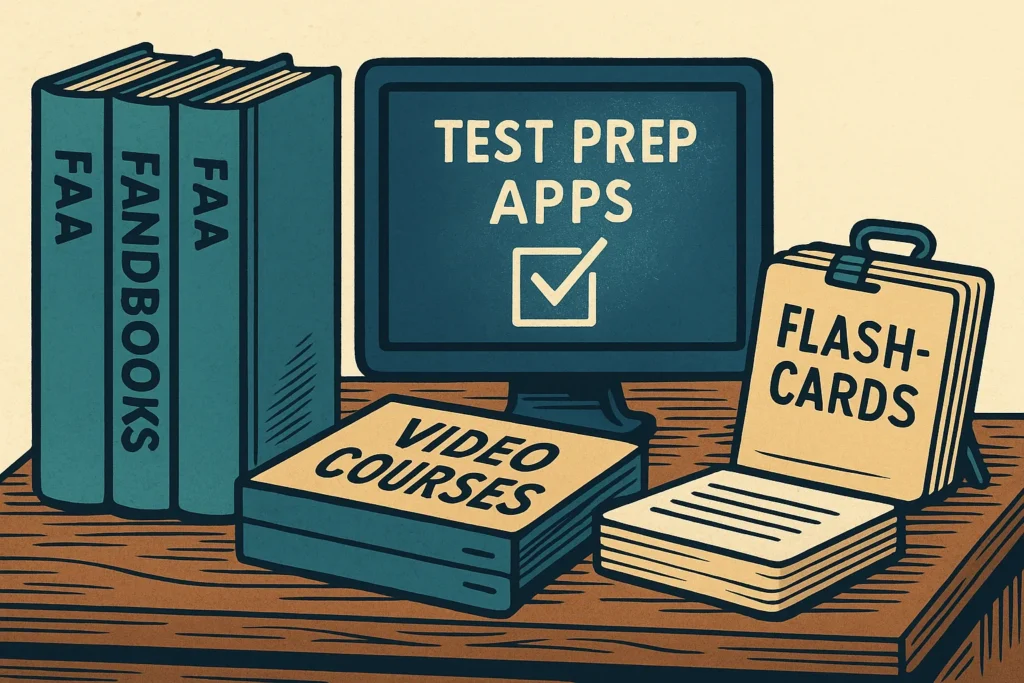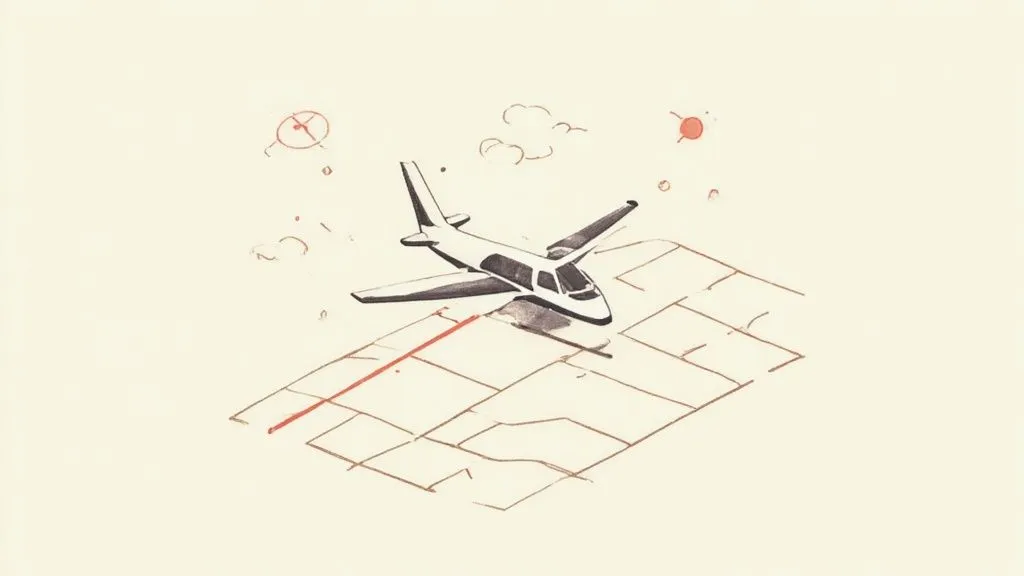Understanding The Real Challenge (And Why It Matters)
The private pilot written test, also known as the Airman Knowledge Test, is a crucial step on the path to becoming a certified pilot. It’s not simply a formality; it’s a thorough evaluation of your grasp of essential aviation concepts. This knowledge isn’t just for passing an exam; it forms the foundation for a safe and successful career in flying.
This isn’t the kind of multiple-choice test you can cram for the night before. The private pilot written test explores complex subjects like meteorology, navigation, regulations, and aircraft systems, requiring a deeper understanding. For instance, understanding weather patterns goes beyond memorizing cloud types; it involves applying that knowledge to make sound decisions during actual flight scenarios. The Airman Knowledge Test is critical for obtaining a private pilot license (PPL) and measures a candidate’s understanding of various aviation topics.
According to 2023 Federal Aviation Administration (FAA) data, a total of 256,801 Airman Knowledge Tests were administered, with an overall pass rate of 91.05% across all categories. However, the first-time pass rate for the private pilot category specifically was around 78% in 2021. (More detailed statistics can be found here: https://aviation101.co/how-many-people-fail-private-pilot-written-test-first-try/) This difference highlights the unique challenges of the private pilot exam.
Deconstructing The Difficulties
Why do many aspiring pilots find this test difficult? Several factors contribute to the complexity:
Depth of Knowledge: The test requires more than simple memorization. It evaluates your capacity to apply learned concepts and make sound decisions based on that understanding.
Breadth of Subjects: The exam covers a wide range of topics, from airspace regulations and flight planning to aircraft systems and aerodynamics. Mastering each area requires focused study.
Application of Knowledge: Many questions involve real-world scenarios, requiring you to analyze information and choose the best course of action using your knowledge.
Test-Taking Strategies: Even with a solid grasp of the material, strong test-taking strategies are essential for navigating challenging questions and managing your time effectively.
These difficulties underscore the importance of well-structured preparation for the private pilot written test. Successfully overcoming this challenge builds a solid foundation for your flight training and future in aviation. It’s an investment in your safety and ultimate success as a pilot.

Private Pilot Written Test FAQs
Before we go too deep into the gory details, let’s cover some of the basics:
1. What is the private pilot written test?
The private pilot written test, officially called the Airman Knowledge Test, is a multiple-choice exam administered by the FAA. It evaluates your understanding of aviation topics like weather, navigation, regulations, and aircraft systems. Passing it is required before taking your checkride.
2. How many questions are on the test, and what’s the passing score?
The test typically includes 60 multiple-choice questions, and you need to score at least 70% to pass. You’ll have 2.5 hours to complete it.
3. How hard is the private pilot written test?
It’s not impossible, but it’s not easy either. The test covers a wide range of topics and expects you to apply knowledge, not just memorize facts. The first-time pass rate is around 78%, which means preparation is key.
4. What happens if I fail the written test?
You can retake it, but you’ll need an instructor’s endorsement before doing so. You’ll also have to pay another testing fee. More importantly, it could delay your flight training and increase costs.
5. When should I take the written test during my flight training?
Many students take it after completing their ground school but before they begin the bulk of their flight lessons. Passing it early ensures you understand the material and helps you progress faster in training.
6. What’s the best way to study for the written test?
Use a mix of resources: FAA handbooks, test prep books, online video courses, and apps with practice tests. Make sure they’re up to date and cover all relevant topics. Study regularly and simulate test conditions with timed practice exams.
7. Do I need an endorsement to take the test?
Yes. You’ll need an instructor or ground school endorsement confirming you’ve completed the necessary training to sit for the exam.
8. How long is my written test result valid?
Your test results are valid for 24 calendar months. If you don’t pass your checkride within that window, you’ll need to retake the written test.
9. Can I take the test online at home?
No. The FAA requires you to take the test at an approved Knowledge Testing Center, such as PSI or CATS locations.
10. How should I choose which study materials to use?
Pick study materials that match your learning style. Visual learners may prefer video-based courses, while structured learners might do better with textbooks and apps. Make sure your materials reflect the latest FAA guidelines.
Why Your First Attempt Actually Matters
Passing your private pilot written test on the first try is more than a personal victory; it significantly impacts your overall training progress. Beyond the disappointment of failing, a retake can trigger a chain reaction affecting your schedule and finances. This can lead to delays in flight training, potentially adding extra costs and extending the time it takes to earn your pilot’s license.
The Real Costs of Retakes
Retaking the written exam directly translates to additional expenses. The retake fee itself is just the beginning. The less obvious costs can be even more significant. For instance, you might need to purchase more study materials or invest in additional instruction, putting unexpected strain on your budget. Moreover, every hour of flight training postponed due to a failed written test represents lost time and increased aircraft rental fees.
The Psychological Impact
Failing the written test can also affect you mentally. Test anxiety can increase with each attempt, making subsequent tests feel even more daunting. This can create a negative cycle of stress and self-doubt, significantly hindering your progress. Passing on the first attempt builds positive momentum, which is essential for successfully navigating the rest of your flight training.
Examining pass rates over time provides insights into candidate performance and industry trends. In 2021, the private pilot written test had a pass rate of approximately 78%, indicating a failure rate of about 22% on the first try. This means roughly one in five aspiring pilots needed at least a second attempt (Tracking Pass Rates). A solid performance on the written exam demonstrates a thorough grasp of the material and reflects positively on your overall preparedness.
Read more about checkride preparation: How to Prepare for Your Private Pilot Checkride
Setting the Tone for Your Aviation Journey
Your approach to the written test establishes the foundation for your entire aviation journey. A dedicated effort resulting in a successful first attempt cultivates discipline and commitment, qualities essential for all aspects of flying. By building a solid base of knowledge from the outset, you create a platform for success in all your future training. This initial investment in thorough preparation for the written test will yield significant returns as you advance through your flight training program.
Choosing Study Materials That Actually Work
Preparing for the private pilot written test is a significant step towards earning your wings. It requires diligent study and the right resources to effectively grasp the complex concepts and regulations. Choosing ineffective materials can lead to frustration, wasted time, and potentially even failure on the exam. This guide will help you navigate the numerous options and build a study strategy that sets you up for success on your first attempt.
Evaluating Test Prep Resources
The market is flooded with private pilot written test prep materials, from comprehensive textbooks to online courses and mobile apps. However, not all resources are created equal. Some may contain outdated information, lack crucial topics, or simply not align with your learning style. Evaluating potential resources beyond their marketing claims is crucial for making an informed decision.
Currency of Information: Aviation regulations and procedures are constantly evolving. Ensure your chosen materials reflect the latest FAA guidelines and updates. Using outdated resources can lead to learning incorrect information, hindering your performance on the exam.
Comprehensive Coverage: Your study materials should cover all aspects of the private pilot knowledge test. Look for resources that address meteorology, navigation, regulations, aircraft systems, and flight operations in detail. Adequate coverage ensures you’re prepared for any question the exam throws your way.
Practice Questions and Explanations: Practice tests are invaluable for solidifying your understanding and familiarizing yourself with the exam format. High-quality study materials include ample practice questions with detailed explanations for both correct and incorrect answers. This reinforces learning and helps identify areas where you need further review.
Learn more about preparing for your flight training journey in our article about choosing a flight school.
Building a Comprehensive Study Toolkit
Often, the most effective approach involves combining different resources. While a commercial study guide provides structured content and practice questions, free FAA resources like the Pilot’s Handbook of Aeronautical Knowledge offer a valuable supplement. Combining a reputable test prep program with official FAA publications creates a well-rounded study toolkit.

This blended approach allows you to tailor your studies to your budget and learning preferences. Incorporating a variety of formats such as textbooks, online courses, and practice exams caters to different learning styles. Supplementing these core resources with videos and interactive tools can further enhance your understanding and retention.
To help you compare popular resources, we’ve compiled the following table:
| Resource Name | Format | Price Range | Practice Questions | Pass Rate Claims | Best For |
|---|---|---|---|---|---|
| Gleim Private Pilot Kit | Book, Online, App | $150 – $250 | 1,500+ | 98% | Structured learners |
| ASA Private Pilot Test Prep | Book, Online | $100 – $150 | 800+ | N/A | Visual learners |
| Sporty’s Private Pilot Test Prep | Online, App | $100 – $200 | 1,000+ | 99% | Tech-savvy learners |
| King Schools Private Pilot Course | Video, Online | $200 – $300 | 600+ | N/A | Auditory learners |
This table provides a general overview and prices may vary. Please check the respective websites for the latest information.
Avoiding Over-Studying and Redundancy
While thorough preparation is essential, over-studying with multiple, redundant materials can be counterproductive. Instead of expanding your knowledge, excessive repetition can lead to information overload and hinder your ability to focus on critical concepts. Prioritize quality over quantity. Choose a few reputable resources that comprehensively cover the necessary topics. This focused approach maximizes learning efficiency and improves information retention.
By carefully evaluating available study materials and selecting a combination of resources tailored to your learning style, you create a powerful study toolkit that sets you up for success on the private pilot written exam. This strategic approach not only saves you valuable time and money but also establishes a strong foundation for your continued aviation journey.
Building Your Personalized Study Strategy
A one-size-fits-all approach to private pilot written test prep simply doesn’t work. Your study strategy needs to be as unique as your schedule, learning style, and existing knowledge. This section will guide you in creating a personalized plan, whether you’re aiming for a 30-day intensive program or a more relaxed 90-day schedule. We’ll explore how to effectively identify your weak areas and strategically allocate your study time.
Assessing Your Starting Point
Before diving into study materials, honestly assess your current aviation knowledge. Are you completely new to the field, or do you have some background? This self-assessment is crucial for determining the intensity and duration of your study plan. For example, someone with prior aviation experience might comfortably tackle an intensive 30-day schedule. A complete beginner might benefit from a longer 90-day approach.
Additionally, consider your learning style. Are you a visual, auditory, or kinesthetic learner? Choosing study materials that cater to your learning style enhances understanding and retention.
Structuring Your Study Plan
Whether you choose a 30-day or 90-day timeframe, a structured approach is key. Break down the material into manageable chunks. Don’t try to absorb everything at once. Focus on mastering one topic at a time, gradually building a solid foundation.
This means dedicating specific time slots for each subject area, ensuring comprehensive coverage of all topics on the private pilot written test.
Identifying and Addressing Weak Areas
As you progress, use practice tests to identify your weak areas. Don’t just take the tests; analyze them thoroughly. Identify patterns in your mistakes. Are you consistently struggling with meteorology questions or navigation calculations?
Pinpointing these weaknesses allows you to focus your study efforts where they’re needed most. This focused approach maximizes your study time and improves your overall performance.
Read also: How to master Aeronautical Decision Making
Adapting Your Strategy Based on Performance
Your personalized study strategy shouldn’t be set in stone. Regularly review your progress and adjust your plan accordingly. Are you exceeding your goals in certain areas? Reallocate that time to focus on more challenging topics. This dynamic approach ensures you’re always maximizing your study efficiency and staying on track for success.
Maintaining Motivation and Building Retention
Private pilot written test prep can be challenging. It’s essential to develop strategies for maintaining motivation and improving retention. For instance, break up long study sessions with shorter review periods. Use flashcards or other memory aids to reinforce key concepts. Reward yourself for reaching milestones. This positive reinforcement keeps you motivated and encourages consistent effort.
Practical Examples and Downloadable Templates
Utilizing practical examples and templates can significantly enhance your study process. A sample study schedule helps you visualize a realistic timeline and allocate specific time slots for each topic. A progress tracker allows you to monitor your performance and identify areas needing improvement. Downloadable templates provide a tangible framework for organizing your study materials and tracking your progress.
This tailored approach allows you to capitalize on your strengths, overcome your weaknesses, and maintain consistent progress toward passing the private pilot written test on your first try. It’s an investment in your future as a safe and competent pilot.
Mastering Practice Tests Beyond Just Taking Them
Simply taking practice tests for your private pilot written exam isn’t enough. The real value lies in using them strategically. You want to refine your understanding and improve your test-taking skills. This section explores how to maximize the benefits of practice tests. We’ll look at analyzing your results, identifying patterns, and fine-tuning your preparation.

Analyzing Your Practice Test Results
Each practice test is a learning opportunity. Don’t just check your score and move on. Instead, dig into each question, especially the ones you missed. Understanding why an answer is incorrect is just as important as knowing the correct answer.
This analysis helps identify knowledge gaps. It also reinforces your understanding of key concepts. For example, consistently missing questions about airspace regulations highlights the need for more focused study in that area.
Identifying Patterns in Your Mistakes
As you take multiple practice tests, look for recurring themes in your errors. Are you misinterpreting questions? Struggling with specific subjects? Or running out of time? Recognizing these patterns is crucial for directing your study efforts.
This focused approach maximizes your study time. It also improves your overall performance. You’ll be able to hone in on the areas where you need the most work.
Simulating Real Testing Conditions
Simulating the actual testing environment is key to gauging your exam readiness. This involves adhering to time limits, minimizing distractions, and using approved materials.
By replicating the pressure and constraints of the real exam, you’ll be better prepared. You’ll learn to manage your time effectively and stay focused on test day.
Question Analysis Techniques and Elimination Strategies
Effective question analysis goes beyond just finding the correct answer. It involves understanding why the incorrect answers are wrong. This deeper understanding strengthens your knowledge. It also prepares you for variations in question phrasing.
Learn to use elimination strategies. Even if you don’t know the answer immediately, eliminating wrong choices significantly increases your odds of selecting the correct one.
Interpreting Your Scores and Predicting Exam Readiness
Your practice test scores are indicators of your progress and exam readiness. Track your scores over time to monitor improvement and identify areas needing additional focus. Remember that practice tests are just one piece of the puzzle. Consistent study and thorough review remain crucial for success.
Read also: How to master using a flight computer
Subject Area Performance Tracking
To help you track your progress, use a table like the one below. It lets you track performance across different knowledge areas, pinpointing strengths and weaknesses for targeted study.
The following table provides a template for tracking your practice test scores. This allows you to identify your strengths and weaknesses across different knowledge areas, so you can prioritize your study efforts effectively.
| Knowledge Area | Practice Test 1 | Practice Test 2 | Practice Test 3 | Improvement Target | Study Priority |
|---|---|---|---|---|---|
| Meteorology | 75% | 82% | 90% | 95% | Medium |
| Navigation | 90% | 88% | 92% | 95% | Low |
| Regulations | 60% | 70% | 75% | 90% | High |
| Aircraft Systems | 80% | 85% | 88% | 95% | Medium |
By mastering these techniques, you’ll transform practice tests into powerful tools. They’ll help improve your understanding and hone your test-taking skills. This strategic approach prepares you for the exam and builds a strong foundation for your aviation journey.
Test Day Execution That Gets Results
All your private pilot written test preparation comes down to this: test day. Success hinges not only on your knowledge but also on performing effectively under pressure. This section covers the practical steps and mental strategies you need for peak performance on the big day. We’ll cover everything from scheduling and required documents to managing test anxiety and maximizing your score.
Pre-Test Logistics: Setting Yourself Up for Success
Planning is crucial before you even arrive at the testing center. Scheduling your exam ahead of time lets you pick a date and time that works best for you, minimizing stress. Ensure you understand the required documentation. Having your identification, endorsements (if needed), and test registration confirmation readily available makes check-in smooth and avoids delays.
Knowing the testing center’s location and parking situation beforehand also helps reduce pre-test jitters. Knowing exactly where to go and how long it takes to get there eliminates unnecessary stress on test day.
Managing Test Anxiety: Staying Calm Under Pressure
Test anxiety is common, but manageable. Deep breathing exercises, visualization techniques, and positive self-talk are powerful tools for calming nerves and maintaining focus. Remember, you’ve prepared; trust in your knowledge.
Also, make sure you arrive at the testing center well-rested and having eaten a nutritious meal. A good night’s sleep and a healthy meal provide the mental clarity and energy needed for your best performance.
Test-Taking Strategies: Maximizing Your Score
Effective test-taking strategies can significantly impact your score. Pace yourself through the 60 questions, allocating time strategically. Don’t get stuck on difficult questions. If you’re unsure, mark it and move on, returning later if time permits.
When faced with unfamiliar material, use the process of elimination. Even if you don’t immediately know the answer, eliminating incorrect choices improves your chances of selecting the correct one.
Read also: Designated Pilot Examiners
Understanding the Testing Environment
The testing environment is typically computer-based. Familiarizing yourself with this format through practice tests will reduce anxiety related to using the computer interface. This allows you to concentrate on the questions, not the delivery method.
Interpreting Your Results and Planning Next Steps
You’ll receive your score immediately after completing the test. Regardless of the outcome, use the information to plan your next steps. If you pass, celebrate and continue your flight training! If not, analyze your performance, pinpoint areas for improvement, and create a plan for retaking the test. Every attempt provides valuable insight into your strengths and weaknesses.
By following these strategies, you’ll not only improve your chances of passing the private pilot written test, but also develop valuable skills that will benefit your aviation career. This test is just the first step on your journey to becoming a skilled and confident pilot.
Your Place In Aviation’s Growing Future
Starting your private pilot journey puts you at an exciting juncture in the aviation industry. Understanding the current state of aviation and its future trajectory can be a great motivator during your private pilot written test preparation. It also provides valuable context for your efforts.
A Growing Demand for Skilled Pilots
The aviation sector is currently experiencing a significant increase in demand for qualified pilots. This growing demand translates to numerous opportunities for newcomers to the field, including private pilots. Performing well on your written exam showcases a commitment to safety and professionalism, setting a strong foundation for your aviation career.
This growth also opens doors to a wider variety of career paths. Beyond recreational flying, private pilots can explore opportunities in aerial photography, pipeline patrol, and introductory flight instruction. A solid understanding of aviation principles, as demonstrated by thorough private pilot written test preparation, sets you up for success in these diverse roles.
This demand isn’t just a trend; it’s supported by market research. The private pilot training ecosystem is rapidly expanding worldwide. The global pilot training market is expected to grow from $9.37 billion in 2024 to $24.86 billion by 2032, a compound annual growth rate (CAGR) of 12.7%. For a more detailed breakdown, check out this market analysis.
Innovation in Pilot Training
The expansion of the aviation industry fuels innovation in training methods. New technologies and resources are constantly being developed, leading to improved learning experiences for aspiring pilots. These advancements include increasingly advanced flight simulators, interactive online courses, and personalized study tools like those offered by Prepware.
By passing the written test, you demonstrate your ability to adapt and thrive within this evolving environment. This adaptability is key to remaining competitive and capitalizing on the opportunities within this exciting field.
Regional Market Variations and Career Paths
The growth and demand for pilots can differ significantly from region to region. Understanding these regional nuances can help you make informed career decisions. Some areas might have a greater need for particular pilot skills, such as specific aircraft type ratings or experience navigating challenging terrain. Researching these variations allows you to customize your training and career path effectively.
Final Thoughts
Your private pilot certificate serves as a stepping stone to a wider range of aviation careers. It’s the foundation upon which you can build specialized skills and acquire advanced certifications. Whether your goal is to become a commercial pilot, a certified flight instructor, or pursue other aviation-related professions, your commitment to diligent preparation now sets the stage for future success. Investing in effective private pilot written test preparation is an investment in your future as a skilled and knowledgeable aviator.
Recent Posts
FAA MOSAIC Final Rule: What Pilots, Manufacturers, and the Aviation Community Need to Know
Learn how the FAA’s MOSAIC final rule revolutionizes Light-Sport Aircraft certification, expands Sport Pilot privileges, and reshapes general aviation. See what’s changing, when it takes effect,...
Student Pilot Insurance: Essential Coverage for Aspiring Flyers
Discover how student pilot insurance can protect your flying dreams. Get expert tips and coverage options to ensure your safety and peace of mind.


